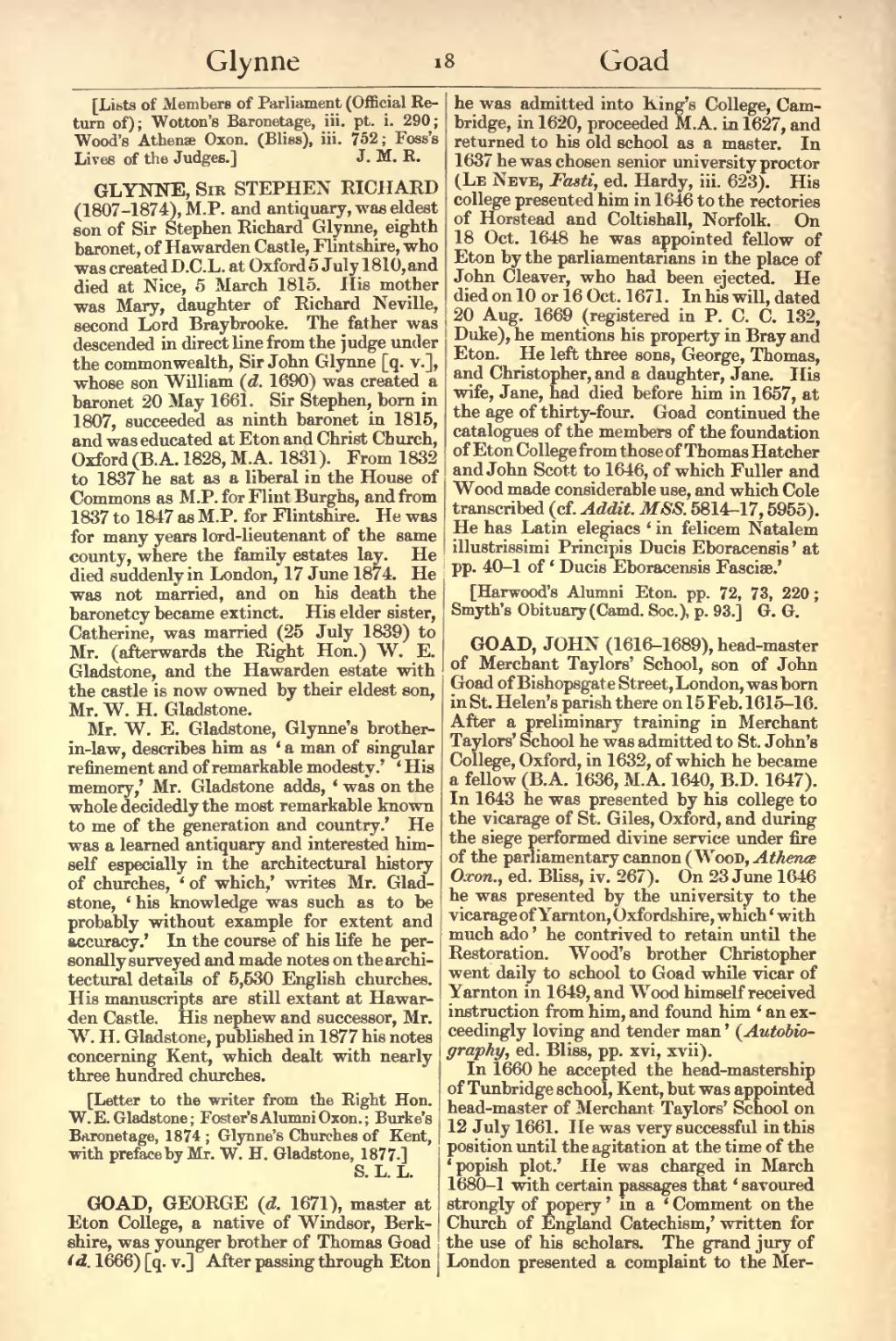[Lists of Members of Parliament (Official Return of); Wotton's Baronetage, iii. pt. i. 290; Wood's Athenæ Oxon. (Bliss), iii. 752; Foss's Lives of the Judges.]
GLYNNE, Sir STEPHEN RICHARD (1807–1874), M.P. and antiquary, was eldest son of Sir Stephen Richard Glynne, eighth baronet, of Hawarden Castle, Flintshire, who was created D.C.L. at Oxford on July 1810, and died at Nice, 5 March 1815. His mother was Mary, daughter of Richard Neville, second Lord Braybrooke. The father was descended in direct line from the judge under the commonwealth, Sir John Glynne [q. v.], whose son William (d. 1690) was created a baronet 20 May 1661. Sir Stephen, born in 1807, succeeded as ninth baronet in 1815, and was educated at Eton and Christ Church, Oxford (B.A. 1828, M.A. 1831). From 1832 to 1837 he sat as a liberal in the House of Commons as M.P. for Flint Burghs, and from 1837 to 1847 as M.P. for Flintshire. He was for many years lord-lieutenant of the same county, where the family estates lay. He died suddenly in London, 17 June 1874. He was not married, and on his death the baronetcy became extinct. His elder sister, Catherine, was married (25 July 1839) to Mr. (afterwards the Right Hon.) W. E. Gladstone, and the Hawarden estate with the castle is now owned by their eldest son, Mr. W. H. Gladstone.
Mr. W. E. Gladstone, Glynne's brother-in-law, describes him as 'a man of singular refinement and of remarkable modesty.' 'His memory,' Mr. Gladstone adds, 'was on the whole decidedly the most remarkable known to me of the generation and country.' He was a learned antiquary and interested himself especially in the architectural history of churches, 'of which,' writes Mr. Gladstone, 'his knowledge was such as to be probably without example for extent and accuracy.' In the course of his life he personally surveyed and made notes on the architectural details of 5,530 English churches. His manuscripts are still extant at Hawarden Castle. His nephew and successor, Mr. W. H. Gladstone, published in 1877 his notes concerning Kent, which dealt with nearly three hundred churches.
[Letter to the writer from the Right Hon. W. E. Gladstone; Foster's Alumni Oxon.; Burke's Baronetage, 1874; Glynne's Churches of Kent, with preface by Mr. W. H. Gladstone, 1877.]
GOAD, GEORGE (d. 1671), master at Eton College, a native of Windsor, Berkshire, was younger brother of Thomas Goad (d. 1666) [q. v.] After passing through Eton he was admitted into King's College, Cambridge, in 1620, proceeded M.A. in 1627, and returned to his old school as a master. In 1637 he was chosen senior university proctor (Le Neve, Fasti, ed. Hardy, iii. 623). His college presented him in 1646 to the rectories of Horstead and Coltishall, Norfolk. On 18 Oct. 1648 he was appointed fellow of Eton by the parliamentarians in the place of John Cleaver, who had been ejected. He died on 10 or 16 Oct. 1671. In his will, dated 20 Aug. 1669 (registered in P. C. C. 132, Duke), he mentions his property in Bray and Eton. He left three sons, George, Thomas, and Christopher, and a daughter, Jane. His wife, Jane, had died before him in 1657, at the age of thirty-four. Goad continued the catalogues of the members of the foundation of Eton College from those of Thomas Hatcher and John Scott to 1646, of which Fuller and Wood made considerable use, and which Cole transcribed (cf. Addit. MSS. 5814-17, 5955). He has Latin elegiacs 'in felicem Natalem illustrissimi Principis Ducis Eboracensis' at pp. 40-1 of 'Ducis Eboracensis Fasciæ.'
[Harwood's Alumni Eton. pp. 72, 73, 220; Smyth's Obituary (Camd. Soc.), p. 93.]
GOAD, JOHN (1616–1689), head-master of Merchant Taylors' School, son of John Goad of Bishopsgate Street, London, was born in St. Helen's parish there on 15 Feb. 1615-16. After a preliminary training in Merchant Taylors' School he was admitted to St. John's College, Oxford, in 1632, of which he became a fellow (B.A. 1636, M.A. 1640, B.D. 1647). In 1643 he was presented by his college to the vicarage of St. Giles, Oxford, and during the siege performed divine service under fire of the parliamentary cannon (Wood, Athenæ Oxon., ed. Bliss, iv. 267). On 23 June 1646 he was presented by the university to the vicarage of Yarnton, Oxfordshire, which 'with much ado' he contrived to retain until the Restoration. Wood's brother Christopher went daily to school to Goad while vicar of Yarnton in 1649, and Wood himself received instruction from him, and found him 'an exceedingly loving and tender man' (Autobiography, ed. Bliss, pp. xvi, xvii).
In 1660 he accepted the head-mastership of Tunbridge school, Kent, but was appointed head-master of Merchant Taylors' School on 12 July 1661. He was very successful in this position until the agitation at the time of the 'popish plot.' He was charged in March 1680-1 with certain passages that 'savoured strongly of popery' in a 'Comment on the Church of England Catechism,' written for the use of his scholars. The grand jury of London presented a complaint to the Mer-
